
Diary: The garden in August 2000

 | Diary: The garden in August 2000 |

|
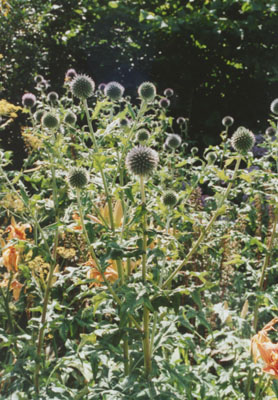
In the vegetable garden we have been picking sugar snap peas and have had a few of the French potatoes. On the 1st there were plenty of pods of Onward peas but they are not yet fully filled. A later planted row, half sugar snap and half onward, has grown well and these are starting to flower and will give a later crop. The broad beans have pods about 10cm long; these too will be left a few days longer to fill out before we harvest some. The runner beans, that have been growing much better since the weather has turned warmer, are covered in pink flowers. Bumblebees have been busy and already several flowers are set and small beans have developed. August is our best month for garden produce and most main meals have at least one vegetable, sometimes several, picked freshly from the garden. There are plenty of lettuce and from the greenhouse an ample, but not excessive supply of tomatoes and cucumbers. The tomato crop has been reduced due to the blossom end rot, but upper trusses are not so badly affected. Gardeners Delight has continued to be completely unaffected. In the last days of July I thinned out the 2 rows of late lettuce plants. I was pleased that they had grown well this year, as sometimes germination is a problem. Unfortunately slugs have attacked the thinned plants. They started at the top of the row and I was able to replace these from a small supply of the thinnings kept back for such an emergency. Such was the attack that these were quickly used up and soon the whole rows were almost eaten up. The slugs preferred the salad bowl varieties as more of the little gem survived! The slugs also were attacking the planted out leeks. The leek was attacked near the white base resulting in the leek being felled, the green leaves being left on the ground. I have not seen this happen before with leeks. Again replacement of the plants led initially to a further attack. In a few days the attacks stopped and what remained were able to grow up. So we might after all have some leeks for the winter months. Also for the winter, and growing well, are purple sprouting broccoli and sea kale beet.

On the 3rd we saw several butterflies in the garden enjoying the sunshine, as we were, in the afternoon. There were 2 red admirals, 2 peacocks and a small tortoiseshell on buddleia that is now in flower. They also frequent large patches of marjoram that are in flower on the rockery banks. On the 8th there were 4 peacocks, 2 red admirals and 2 tortoiseshells. Thinking of next year 2 of our old wooden bird nesting boxes, that have done good service for at least 10 years, were taken down from trees and replaced by new German models. The wooden boxes were always popular with blue tits and were occupied every year. They were becoming dilapidated so needed replacement. The new boxes have the smaller 26mm hole suitable for blue tits and should exclude larger birds. It is a good idea putting them up at this time of year would allow the birds plenty of time to investigate them. There is usually a lot of activity at the boxes during the winter months. 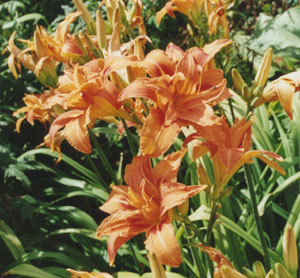 We continue to feed the birds at this time of year, but in smaller quantities. Food is put out once a day, in the morning, in a quantity that is completely consumed in the day. In past years we did not feed during the summer but current thought is that it is beneficial. Certainly early summer feeding enables adult birds to concentrate feeding natural food to their offspring. Numbers of birds in the garden tend to be at their smallest this month and next. We stop feeding at the regular feeding stations and, if possible, move them to fresh ground to minimise possibility of spreading disease. Sightings of spotted flycatchers have been very few this summer. We have not seen the families seen in previous years and fear that the dull and wet weather has again taken its toll. Numbers of spotted flycatchers have seriously diminished in recent years over the country as a whole. In the flower borders the hydrangeas Hydrangea macrophylla sp. are at their best now. As the soil here is slightly acidic they tend to be blue, but sometimes turn pink as the season progresses. While they will thrive in almost any soil they are particularly useful here, as they will grow in partial shade. Also here in the west there is little trouble with frost that could cause damage. Patricia is particularly fond of a lace-cap form that has a large flat flower head with small fertile flowers at the centre surrounded with larger sterile florets. We have some of both sorts next to the rhododendrons. As the rhododendrons are no longer in flower the hydrangeas are giving an alternative splash of colour. In the herbaceous border the day-lilies Hemerocallis are continuing to give a good display. Named from the Greek hemera, day, and kallos, beauty; we think that the original plant came to the family from South Africa. It is one of several plants of which the flowers 'open for a day' then die. It has been doing this for several weeks and shows no sign of diminishing its ability to produce numerous buds and flowers. The white Lychnis, the globe thistles Echinops and bronze fennel that has yellow flowers continue also to provide interest and colour. There are Welsh poppies continuing to flower, but not in the profusion seen earlier in the year, both orange and a few yellow. But it is the new border in front of the greenhouse, which has come into its own for the first time. With the dominant theme being grey leaves the aromatic lavenders have been excellent. As well as the common sort Lavendula angustifolium Patricia has collected several varieties to grow in this border. These include spica vera, a pink
We continue to feed the birds at this time of year, but in smaller quantities. Food is put out once a day, in the morning, in a quantity that is completely consumed in the day. In past years we did not feed during the summer but current thought is that it is beneficial. Certainly early summer feeding enables adult birds to concentrate feeding natural food to their offspring. Numbers of birds in the garden tend to be at their smallest this month and next. We stop feeding at the regular feeding stations and, if possible, move them to fresh ground to minimise possibility of spreading disease. Sightings of spotted flycatchers have been very few this summer. We have not seen the families seen in previous years and fear that the dull and wet weather has again taken its toll. Numbers of spotted flycatchers have seriously diminished in recent years over the country as a whole. In the flower borders the hydrangeas Hydrangea macrophylla sp. are at their best now. As the soil here is slightly acidic they tend to be blue, but sometimes turn pink as the season progresses. While they will thrive in almost any soil they are particularly useful here, as they will grow in partial shade. Also here in the west there is little trouble with frost that could cause damage. Patricia is particularly fond of a lace-cap form that has a large flat flower head with small fertile flowers at the centre surrounded with larger sterile florets. We have some of both sorts next to the rhododendrons. As the rhododendrons are no longer in flower the hydrangeas are giving an alternative splash of colour. In the herbaceous border the day-lilies Hemerocallis are continuing to give a good display. Named from the Greek hemera, day, and kallos, beauty; we think that the original plant came to the family from South Africa. It is one of several plants of which the flowers 'open for a day' then die. It has been doing this for several weeks and shows no sign of diminishing its ability to produce numerous buds and flowers. The white Lychnis, the globe thistles Echinops and bronze fennel that has yellow flowers continue also to provide interest and colour. There are Welsh poppies continuing to flower, but not in the profusion seen earlier in the year, both orange and a few yellow. But it is the new border in front of the greenhouse, which has come into its own for the first time. With the dominant theme being grey leaves the aromatic lavenders have been excellent. As well as the common sort Lavendula angustifolium Patricia has collected several varieties to grow in this border. These include spica vera, a pink 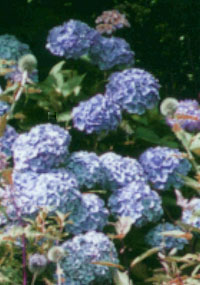 rosea, and white alba. We have dwarf Munstead that at one time grew as a small hedge around this plot when used for vegetables, and dark Hidcote. Of the newer sorts, to us, are varieties of the French lavender L. stoechas vars. Papillion, Fat head and Helmsdale. The French lavenders have been flowering since late spring and show no sign of stopping at present. All the lavenders have shown tolerance of spells of wet and windy weather. Some of the common flower heads have been gathered and dried to keep in a bowl in the house to remind us of summer later in the year. Also in this border we have several plants of 'Brittany' sage (Blackcurrant sage) propagated from cuttings given to us by friends in Brittany. This shrub has a profusion of small red flowers that continue all summer. It tends to be intolerant of wind, and probably of frost, so we make sure that we have a stock of cuttings coming along to make replacements. The middle of the month and yet no spell of settled summer weather. There have been odd days that have given a glimpse of what it could be like but the impression has been that here, at least, the summer has passed us by.
rosea, and white alba. We have dwarf Munstead that at one time grew as a small hedge around this plot when used for vegetables, and dark Hidcote. Of the newer sorts, to us, are varieties of the French lavender L. stoechas vars. Papillion, Fat head and Helmsdale. The French lavenders have been flowering since late spring and show no sign of stopping at present. All the lavenders have shown tolerance of spells of wet and windy weather. Some of the common flower heads have been gathered and dried to keep in a bowl in the house to remind us of summer later in the year. Also in this border we have several plants of 'Brittany' sage (Blackcurrant sage) propagated from cuttings given to us by friends in Brittany. This shrub has a profusion of small red flowers that continue all summer. It tends to be intolerant of wind, and probably of frost, so we make sure that we have a stock of cuttings coming along to make replacements. The middle of the month and yet no spell of settled summer weather. There have been odd days that have given a glimpse of what it could be like but the impression has been that here, at least, the summer has passed us by. 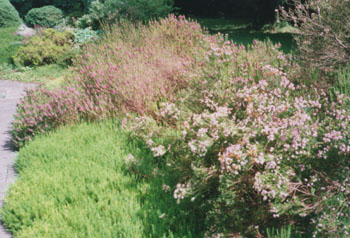 The 12th was typical with an overcast sky and rain or drizzle most of the day. It was warm, however, and bumblebees were busy feeding in the rain on the heathers in borders on the south side of the house. These heathers are a good food source at this time of year, for bees and insects, as other flowering plants become less. There is the shorter Cornish Heath Erica vegans, native of Cornwall, var. Mrs D F Maxwell a deep rose-cerise with dark green foliage, and a taller tree heather, the Corsican Heath Erica terminalis, having pink flowers. The Corsican starts flowering first, usually in July and both can carry on into October. The Corsican, tolerant of lime readily seeds itself but the Cornish needs to be propagated by cuttings. Both types are reasonably hardy and are well over 30 years old; we planted them when we came to live here. The high spot of the day was our first picking of broad beans and very nice they were too. Two days latter we were able to have the first runner beans. These have now done very well and there are plenty of beans to come over the next weeks. They are a favourite with all the family freshly picked, sliced and boiled. If too many are cooked, and this is easily done when the crop is good, they are excellent cold the next day with salad.
The 12th was typical with an overcast sky and rain or drizzle most of the day. It was warm, however, and bumblebees were busy feeding in the rain on the heathers in borders on the south side of the house. These heathers are a good food source at this time of year, for bees and insects, as other flowering plants become less. There is the shorter Cornish Heath Erica vegans, native of Cornwall, var. Mrs D F Maxwell a deep rose-cerise with dark green foliage, and a taller tree heather, the Corsican Heath Erica terminalis, having pink flowers. The Corsican starts flowering first, usually in July and both can carry on into October. The Corsican, tolerant of lime readily seeds itself but the Cornish needs to be propagated by cuttings. Both types are reasonably hardy and are well over 30 years old; we planted them when we came to live here. The high spot of the day was our first picking of broad beans and very nice they were too. Two days latter we were able to have the first runner beans. These have now done very well and there are plenty of beans to come over the next weeks. They are a favourite with all the family freshly picked, sliced and boiled. If too many are cooked, and this is easily done when the crop is good, they are excellent cold the next day with salad.
On the 15th on an unpromising start to the day the afternoon became bright and sunny. Opportunity was taken for a walk around the lanes. My first stopping place was at a pipe outlet draining fields into a stream, popular with our children when they were small! This, over the years, has been a good indicator of the water regime. Today water was flowing strongly out of the pipe indicating that the soils were saturated and recent rainfalls were running off the ground. In some summers there is barely a trickle, but not this one. The barley in the field, I have previously described, has been harvested but the harvester lies temporarily abandoned in a corner. The cereals have been ready to harvest for a while but the wet weather has largely held up this work. In recent years, with the earlier maturing varieties available, harvests have been getting earlier. This year it will be somewhat later but not as late as September or even early October in a really poor year in the past. I can remember as a boy visiting on several occasions a farm in Gower to 'help' when the corn was cut, by reaper and binder, and the sheaves stood on the field in stooks to dry. These were then collected, often by horsedrawn wagon, and put in a corn-rick with a thatched straw roof to keep it dry. There it stood until the mobile steam-driven thrashing machine visited, later in the year, to remove the ears from the straw. All these events were, it seems, something that lots of people were closely involved in at the time. Today with modern machinery 'help' is not required and involvement is noting the event in a diary. This year's harvest was spread over several weeks, as drier weather permitted, in what was a very wet month. 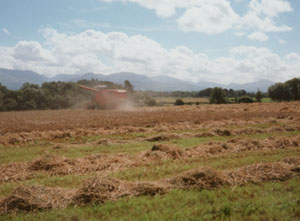 Further along the lane I saw a flock of about 100 sparrows, they were noisily darting to and fro a hedge bordering the harvested and the next unharvested field. Sparrows do flock up in the summer months, I have seen flocks of 20-30 earlier but this is the largest seen this year. Sparrows have disappeared from the garden; this is where they must be! No doubt some will be back later in the year when supplies of seeds run low in the fields and along the hedgerows. At present there is plenty of seed available including grasses, plantains, cow parsley and dock. In flower was the greater knapweed Centaurea scabiosa that was attracting some small tortoiseshell butterflies. Some of the berries on hawthorn were already turning red but I could not find any sloes. This is the second year that sloes have failed to form hereabouts. Blackberries are starting to ripen; a few sample berries proved delicious! Across the lane from the sparrows the rooks (200 or more) were hunting over the pastures.
Further along the lane I saw a flock of about 100 sparrows, they were noisily darting to and fro a hedge bordering the harvested and the next unharvested field. Sparrows do flock up in the summer months, I have seen flocks of 20-30 earlier but this is the largest seen this year. Sparrows have disappeared from the garden; this is where they must be! No doubt some will be back later in the year when supplies of seeds run low in the fields and along the hedgerows. At present there is plenty of seed available including grasses, plantains, cow parsley and dock. In flower was the greater knapweed Centaurea scabiosa that was attracting some small tortoiseshell butterflies. Some of the berries on hawthorn were already turning red but I could not find any sloes. This is the second year that sloes have failed to form hereabouts. Blackberries are starting to ripen; a few sample berries proved delicious! Across the lane from the sparrows the rooks (200 or more) were hunting over the pastures.
It was back to the damp and muggy weather on the 16th. This weather has brought on fungal attacks in the greenhouse and the garden. Tomato leaves affected by Botrytis have been cut off and as much air given as possible to minimise its spread. Despite this the tomatoes are cropping well at the moment. There is the first sign of the Black Hamburg grapes beginning to ripen. On the vegetable plot there is already sign of a little damage to potato leaves by blight. The sweet peas have passed their best. They are now at the top of their support and have got small and few in number. Usually they continue at least until the end of the month, but not this year, and will be missed as cut flowers for the house. We have not had the profusion of roses that we would have liked to see on the Zephirene Drouhin this year. It has not repeated as well as other years. But the new roses, The Herbalist and Cottage Rose have been doing quite well.
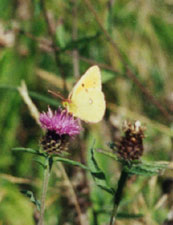
With most of the grain harvest completed the fields and roads are becoming quieter as combine harvesters are put away for another year. Grass has been mown for silage, wilted then gathered into big bales and covered with black polythene. More recently some grass has been dried for hay, usually these days in large bales but there are still quite a lot of small rectangular bales being made in parts of the island. The field to the northeast of the garden, beyond the greenhouse and wood, has recently been cut for hay, as it has been turned to dry on a sunny day the pleasant sweet smell was drifting across on a gentle breeze. Some days later the aroma was not as pleasant when manure was spread! Later sheep were returned to graze, for most of the summer they have been in far off fields. The other 2 fields near the garden have continued to have cattle. Completion of the grain harvests leaves many fields standing bare of crops, for a while, before autumn ploughing begins. 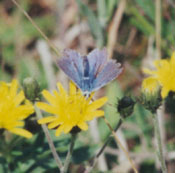 This is the time of year that Canada geese come to graze the stubbled fields. They frequently fly over the garden and we hear them coming, before we see them, with their familiar honking calls as they fly over in V formation. Sometimes they are in small groups of 10-15 birds but we have seen 30 or more at a time. They have been flying over since the beginning of the month, often in late afternoon or evening and settle on fields just to the southeast of here. In the morning they fly off again probably to the estuaries and waterways around Anglesey. One such estuary is at Malltraeth and along its banks is a favourite walk. On the southern side is Newborough Forest that borders Newborough (Warren) National Nature Reserve, an important sand dune system. Both were the same sand dunes part of which was forested before, what was left, was declared an NNR shortly after the 1947 Countryside Act. The walk is along a strip of land between the forest and the shore. At certain times of the tide interesting birds, including Canada geese, can be seen and the forest area is home to many ravens. The narrow strip of vegetation, between forest and salt marsh, is very interesting as it is ungrazed meadow containing many plant species. This supports a good number of insects and butterflies. This year has been very good for butterflies and, as well as the small common blue, we have been seeing a large number of clouded yellow, several gatekeepers and small tortoiseshells. Visits on sunny days between the 20th and 29th were no exception.
This is the time of year that Canada geese come to graze the stubbled fields. They frequently fly over the garden and we hear them coming, before we see them, with their familiar honking calls as they fly over in V formation. Sometimes they are in small groups of 10-15 birds but we have seen 30 or more at a time. They have been flying over since the beginning of the month, often in late afternoon or evening and settle on fields just to the southeast of here. In the morning they fly off again probably to the estuaries and waterways around Anglesey. One such estuary is at Malltraeth and along its banks is a favourite walk. On the southern side is Newborough Forest that borders Newborough (Warren) National Nature Reserve, an important sand dune system. Both were the same sand dunes part of which was forested before, what was left, was declared an NNR shortly after the 1947 Countryside Act. The walk is along a strip of land between the forest and the shore. At certain times of the tide interesting birds, including Canada geese, can be seen and the forest area is home to many ravens. The narrow strip of vegetation, between forest and salt marsh, is very interesting as it is ungrazed meadow containing many plant species. This supports a good number of insects and butterflies. This year has been very good for butterflies and, as well as the small common blue, we have been seeing a large number of clouded yellow, several gatekeepers and small tortoiseshells. Visits on sunny days between the 20th and 29th were no exception. 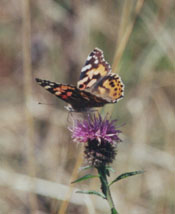 The clouded yellow is a southern European species that is a strong migrant. In spring it flies north and can reach Britain by June, perhaps assisted by air-flows from the south; there have been several instances this year that has resulted in deposition of Saharan dust (see Weather diary). Arriving in Britain by June it can establish a late brood that flies in August. We have seen them here several times in the last 5 years and, although chances of them surviving resident as a result of recent warm years must be small, it is tempting to think that a few may survive overwinter! One, possibly two yellow butterflies looked darker with a flush of orange, and a little larger. These were very difficult, as were the clouded yellow, to get a close look and photograph with wings open, I missed a good shot by seconds. They
The clouded yellow is a southern European species that is a strong migrant. In spring it flies north and can reach Britain by June, perhaps assisted by air-flows from the south; there have been several instances this year that has resulted in deposition of Saharan dust (see Weather diary). Arriving in Britain by June it can establish a late brood that flies in August. We have seen them here several times in the last 5 years and, although chances of them surviving resident as a result of recent warm years must be small, it is tempting to think that a few may survive overwinter! One, possibly two yellow butterflies looked darker with a flush of orange, and a little larger. These were very difficult, as were the clouded yellow, to get a close look and photograph with wings open, I missed a good shot by seconds. They 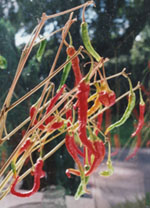 looked like the Cleopatra that occurs in north Africa and southern Europe. Again in view of the episodes of Saharan dust this year it is possible that with an assisted passage they were Cleopatras! There were several gatekeepers around as well and we had a good view of them feeding on Calluna that was in flower. This is another southern species and it is very good to see them so far north as Anglesey. The swallows have already begun to line up on overhead cables, a 100 or more were seen near Brynsiencyn, in preparation for their migration south for the winter. It will be a few days before they set off, but we will one-day find they are no longer around. It will be a long journey for them with many hazards to overcome; it will be a long wait for us before we welcome them again next year.
looked like the Cleopatra that occurs in north Africa and southern Europe. Again in view of the episodes of Saharan dust this year it is possible that with an assisted passage they were Cleopatras! There were several gatekeepers around as well and we had a good view of them feeding on Calluna that was in flower. This is another southern species and it is very good to see them so far north as Anglesey. The swallows have already begun to line up on overhead cables, a 100 or more were seen near Brynsiencyn, in preparation for their migration south for the winter. It will be a few days before they set off, but we will one-day find they are no longer around. It will be a long journey for them with many hazards to overcome; it will be a long wait for us before we welcome them again next year.
The 31st was a wet and windy day. Patricia harvested our crop of hot Mexican chillies that have been growing in the greenhouse. Some have already turned red but most are still green. We find it best to cut off the stems, with chillies attached, and bring them into the house. These are placed in a dry pot in a sunny window and the chillies turn red and gradually dry out. When dry they can be stored for use when required. I made use of several straight away making the first batch of chutney of the season. A little early but during the week Tesco had a special offer on mangoes '2 for the price of 1'. As this is favourite chutney I could not resist the offer! For my own special recipe see our recipes page.
Document dated: 2 September 2000. This page is part of the site maintained at http://www.llansadwrn-wx.co.uk
Copyright ©: 2000 Donald and Patricia Perkins